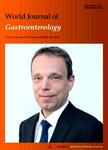Ischemic or toxic injury: A challenging diagnosis and treatment of drug-induced stenosis of the sigmoid colon
Ischemic or toxic injury: A challenging diagnosis and treatment of drug-induced stenosis of the sigmoid colon作者机构:Department of General SurgeryBeijing Electric Power HospitalState Grid Corporation of ChinaCapital Medical University Department of GastroenterologyPeking University International Hospital Asian Liver Center and Department of SurgerySchool of MedicineStanford University Department of GastroenterologyBeijing Electric Power HospitalState Grid Corporation of ChinaCapital Medical University Department of GastroenterologyFirst HospitalShanxi Medical University Department of GastroenterologyJinan Military General Hospital Department of RadiologyBeijing Electric Power HospitalState Grid Corporation of ChinaCapital Medical University Department of PathologyBeijing Electric Power HospitalState Grid Corporation of ChinaCapital Medical University Department of PathologyPeking University Third HospitalSchool of Basic Medical SciencesPeking University Health Science Center1 Department of PathologyPeking Union Medical College HospitalChinese Academy of Medical Sciences
出 版 物:《World Journal of Gastroenterology》 (世界胃肠病学杂志(英文版))
年 卷 期:2017年第23卷第21期
页 面:3934-3944页
核心收录:
学科分类:1002[医学-临床医学] 100210[医学-外科学(含:普外、骨外、泌尿外、胸心外、神外、整形、烧伤、野战外)] 10[医学]
基 金:Supported by the Science and Technology Project of State Grid Corporation of China No.SGHB0000AJJS1400182
主 题:Benign colonic stenosis Compound Qingdai pill Self-expandable memory metallic stent
摘 要:A 48-year-old woman was admitted with 15-mo history of abdominal pain, diarrhea and hematochezia, and 5-mo history of defecation difficulty. She had been successively admitted to nine hospitals, with an initial diagnosis of inflammatory bowel disease with stenotic sigmoid colon. Findings from computed tomography virtual colonoscopy, radiography with meglumine diatrizoate, endoscopic balloon dilatation, metallic stent implantation and later overall colonoscopy, coupled with the newfound knowledge of compound Qingdai pill-taking, led to a subsequent diagnosis of ischemic or toxic bowel disease with sigmoid colon stenosis. The patient was successfully treated by laparoscopic sigmoid colectomy, and postoperative pathological examination revealed ischemic or toxic injury of the sigmoid colon, providing a final diagnosis of druginduced sigmoid colon stenosis. This case highlights that adequate awareness of drug-induced colon stenosis has a decisive role in avoiding misdiagnosis and mistreatment. The diagnostic and therapeutic experiences learnt from this case suggest that endoscopic balloon expansion and colonic metallic stent implantation as bridge treatments were demonstrated as crucial for the differential diagnosis of benign colonic stenosis. Skillful surgical technique and appropriate perioperative management helped to ensure the safety of our patient in subsequent surgery after long-term use of glucocorticoids.



